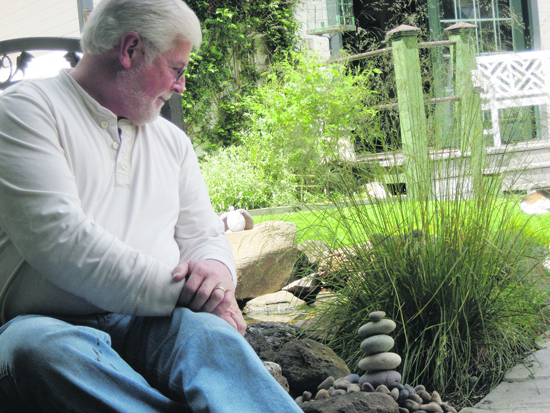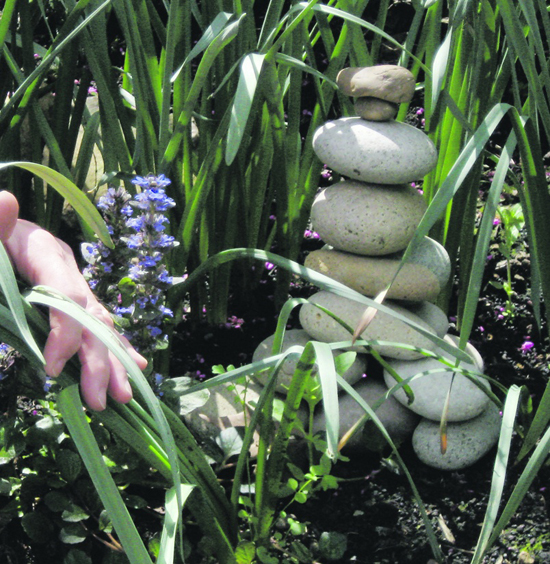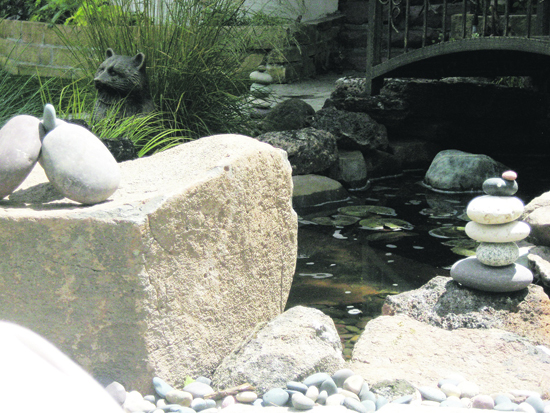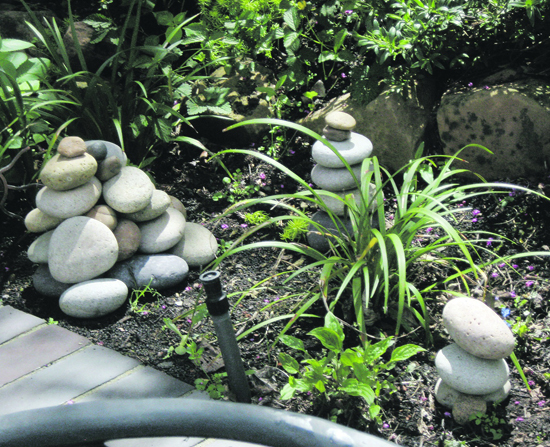 | | | Stu Selland in his back yard Photos Sophie Braccini
| | | | | | If you're looking for a fun way to entertain your guests (or your family) during a sunny summer afternoon, look no further. A cairn building party is a great way to exercise creativity. We are not talking about a 10-foot-high dry stone building here, just small stone formations, hidden or in plain sight, that gently enhance a landscape. That's the activity Lafayette resident Stu Selland recently proposed to his guests. They had a great time, and as a token of appreciation, they left their ephemeral creations in his garden.
 "I was looking for an activity to entertain my friends from my 'Close to Home' hiking group," explains Selland who is a photographer by profession, as well as a gardener and volleyball coach. "Like in photography, I like to reveal the extraordinary in the ordinary. I wanted something that would have them experience that concept." When he saw a video clip with children building little cairns along a river bank, he knew he had his activity.
"I was looking for an activity to entertain my friends from my 'Close to Home' hiking group," explains Selland who is a photographer by profession, as well as a gardener and volleyball coach. "Like in photography, I like to reveal the extraordinary in the ordinary. I wanted something that would have them experience that concept." When he saw a video clip with children building little cairns along a river bank, he knew he had his activity.
 Cairns of all shapes, sizes and purposes have graced the earth since the prehistoric times: Man-made dry rock tumuli (mounds of earth and stones) have been used as grave markers or for religious purposes. They range in size from the tiny pile of a few decorative rocks to entire hills. In modern America, they are used to mark trails, especially in mountain regions. Depending on how they're built, they can be short lived or last millennia. "What I had in mind were small sculptures that would take just a few minutes to build," says Selland.
Cairns of all shapes, sizes and purposes have graced the earth since the prehistoric times: Man-made dry rock tumuli (mounds of earth and stones) have been used as grave markers or for religious purposes. They range in size from the tiny pile of a few decorative rocks to entire hills. In modern America, they are used to mark trails, especially in mountain regions. Depending on how they're built, they can be short lived or last millennia. "What I had in mind were small sculptures that would take just a few minutes to build," says Selland.
 Selland bought a large amount of small rocks of all shapes at Diamond K in Lafayette. All his guests had to do was pick the ones they liked and try their hand at it.
Selland bought a large amount of small rocks of all shapes at Diamond K in Lafayette. All his guests had to do was pick the ones they liked and try their hand at it.
 "A delightful exercise in slowing down," says guest Renate Woodbury. "The rounded river rocks Stu had available can be hard to stack - looking for that perfect connection between one rock and another requires a fragile balance."
"A delightful exercise in slowing down," says guest Renate Woodbury. "The rounded river rocks Stu had available can be hard to stack - looking for that perfect connection between one rock and another requires a fragile balance."
 Since that afternoon, Woodbury has gained a greater appreciation for cairns on a trail. "In my youth I called them ducks, not cairns," she says. "I thought ducks were for sissies who couldn't find their own way through the wilderness. I always kicked them down. Well, nowadays I find great comfort in seeing a duck ahead of me. It reassures me that I am on the right path."
Since that afternoon, Woodbury has gained a greater appreciation for cairns on a trail. "In my youth I called them ducks, not cairns," she says. "I thought ducks were for sissies who couldn't find their own way through the wilderness. I always kicked them down. Well, nowadays I find great comfort in seeing a duck ahead of me. It reassures me that I am on the right path."
 "Building the cairns was a learning experience," agrees Bob Flasher. "It is a challenge balancing round rocks, which makes you wish you had a chasm to pitch them into. But once you lower your expectations, it becomes less frustrating and more enjoyable. We gave each other creative suggestions and ended up trying lots of different shapes. It was really an enjoyable way to spend an afternoon, and Stu's garden is more unique as a result. We're hoping that the cat doesn't rub against any of the teetery ones, or its purr will turn to a yelp faster than white on rice!"
"Building the cairns was a learning experience," agrees Bob Flasher. "It is a challenge balancing round rocks, which makes you wish you had a chasm to pitch them into. But once you lower your expectations, it becomes less frustrating and more enjoyable. We gave each other creative suggestions and ended up trying lots of different shapes. It was really an enjoyable way to spend an afternoon, and Stu's garden is more unique as a result. We're hoping that the cat doesn't rub against any of the teetery ones, or its purr will turn to a yelp faster than white on rice!"
 Visiting with Selland a few weeks after the party, all of the cairns were still up in the garden. "I am still discovering some of them," says Selland, showing a small three-stone cairn that someone had left for him in his studio. The biggest ones were made of about 20 stones, all quite different from one another and blending in the surrounding landscape, so discovering one is always a charming surprise. "They each used a different place in the garden that inspired them, and left their creation behind for us to enjoy," says Selland. "Creativity is inside all of us; it's about learning and paying attention."
Visiting with Selland a few weeks after the party, all of the cairns were still up in the garden. "I am still discovering some of them," says Selland, showing a small three-stone cairn that someone had left for him in his studio. The biggest ones were made of about 20 stones, all quite different from one another and blending in the surrounding landscape, so discovering one is always a charming surprise. "They each used a different place in the garden that inspired them, and left their creation behind for us to enjoy," says Selland. "Creativity is inside all of us; it's about learning and paying attention."

|



